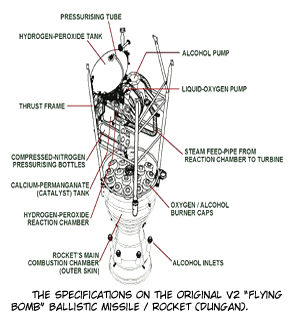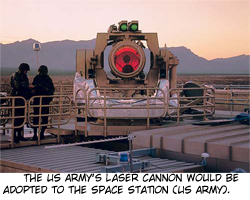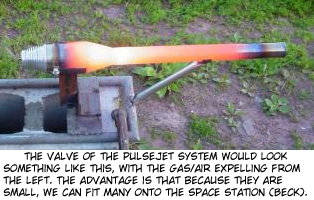|
To cure boredom and intrigue minds alike... it seems to work. Copyright joeshen 2007 |
|||||
|
When Rocks become Dangerous – Space Station Collision Response
By: Joseph Shen . 9 March 2007 |
||||
For the “Diffusion” process, the use of a laser cannon is involved. Having the laser mounted on the center (where the zero gravity structure is), would give it the ability to rotate 360 degrees, and with the pulsejet system it would able to fire a laser in virtually all directions in a 3-D axis. The U.S. Army is already using laser cannons as a defense measurement should a ballistic missile be headed towards the United States (U.S. Army Mobile), and the Air Force unveiled a fleet of Boeing’s equipped with Airborne Laser Cannons as an added defense measurement (ABL YAL 1A Airborne Laser). The design of these Laser Cannons was to cause the circuit within’ the ballistic missile to overheat, thereby causing an internal malfunction and self-destruct while still in flight. So, from there the whole logistics behind the “Diffusion” response is simple: after the explosive charges are placed on or within’ the asteroid / flying object coming towards the space station, the laser would direct a concentrated beam at the asteroid, causing the charges to detonate, and either deflect or remove the threat of the asteroid colliding with the space station.   I said earlier that all three systems could be intertwined, which is true. The pulsejet systems can rotate the space station to allow the mounted laser cannon to be able to fire in all directions, which would allow for the mining of asteroids to be easier, as the detonation of charges to blow up asteroids to smaller pieces possible and safer than using remote-controlled charges. The laser would also serve as the “painting” device for the ballistic missiles, so their laser guidance system would “lock-on” to the asteroid itself as well as the detonation of explosive charges, and the combination of these two defense systems would provide enough to safely divert an asteroid of any size or magnitude from the space station. Any recoil from the firing of the missiles can be easily countered by firing off the pulsejets. Should the need occur, the pulse jet systems would successfully be able to move away from the asteroid’s trajectory and safely let the asteroid pass through. A fourth collision response would be to tugboat the asteroid, slowing changing its axis of rotation and slowly over time change its rotation, which would cause its trajectory to change as well. Currently, NASA is working on blueprints to use this idea to divert an asteroid from colliding with the Earth in future (David). This response however, cannot be combined with the other three, and would only serve beneficial if we know about the asteroid in advance. Through the use of these response systems, we would be able to successfully avoid any collision of an asteroid, and be able to apply the use of the laser cannon to the industrial side of the Space Station; It’s a win-win situation for everybody.
|
Works Cited:
- "ABL YAL 1A Airborne Laser, USA." Airforce Technology. 2007. 7 Mar 2007 - Beck, Eric. "All About Pulsejet Engines." Beck-Technologies. 2005. 8 Mar 2007 - David, Leonard. "Mission Possible: Asteroid Tugboat Backed for Trial Run." Space.com 15 Oct 2003 3. 08 Mar 2007 -Dungan, Tracy. V2Rocket.com. Brothers Designs. 9 Mar 2007 - Kanipe, Jeff. "Astronomers hash out defense against asteroids." News Network 9 Mar 2007 3. 9 Mar 2007 - "U.S. Army Mobile Tactical High Energy Laser." Popular Mechanics Apr 2003 2. 8 Mar 2007
| Copyright Joseph Shen 2007 |
